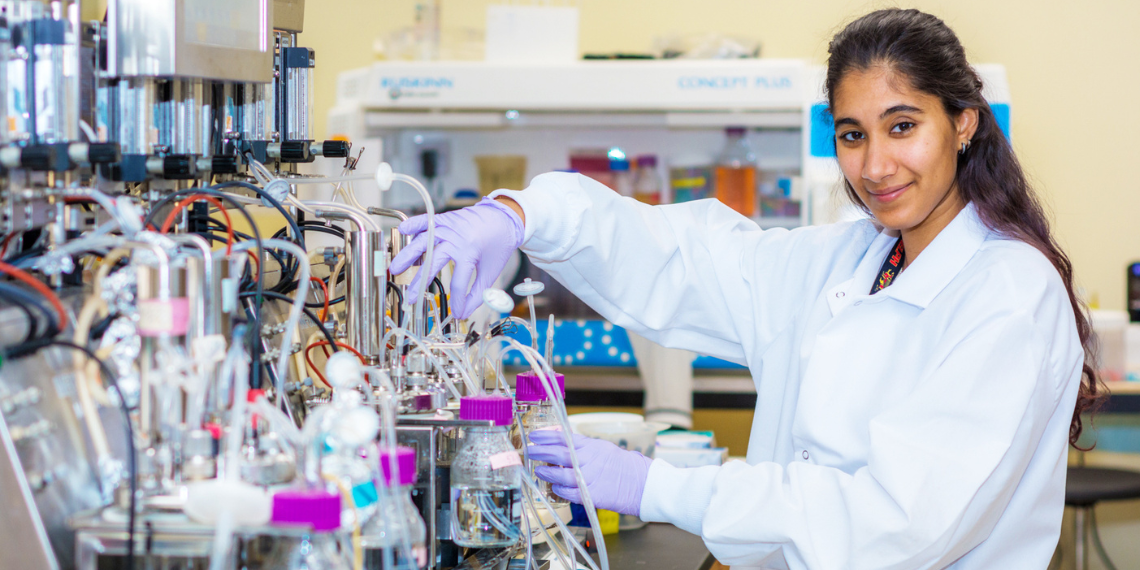Feeding the Microbiome: How Human Milk Influences Gut Health Beyond Infancy

For decades, breastmilk has been recognized not only for its nutritional value but also for its critical role in shaping a protective microbial community in the infant gut. But what happens after breastfeeding ends? Can its early microbial benefits be sustained or even reintroduced later in life?
To answer these intriguing but complex questions, you need to start by looking at what’s in human breastmilk and what exactly it does, according to Department of Molecular and Cellular Biology researchers Dr. Emma Allen-Vercoe, a professor of microbiology, and Dr. Simone Renwick, a former PhD student in the Allen-Vercoe lab.
“Some of the main components of breastmilk are complex sugars knowns as human milk oligosaccharides or ‘HMOs’, which play a key role in healthy gut development in early life,” explains Renwick.
In fact, commercially produced HMOs are now commonly added to infant formula, where they are believed to provide a variety of health benefits.
“However, we actually know very little about the ability of HMOs to alter the gut microbiomes of young children after weaning,” says Renwick.
Working with an international team of researchers, Allen-Vercoe and Renwick focused on toddlers (18 to 24 months in age) who were no longer breastfeeding, but still at a critical stage of microbiome development.
The study began by collecting stool samples from seven toddlers, which were each cultured within the Allen-Vercoe lab’s “Robogut” systems – bioreactors which mimic the environment of the human gut. These communities were then treated with either HMOs isolated from pooled human milk samples (containing more than 150 HMOs) or 2’FL (the HMO most commonly added to infant formula). Microbial communities given pooled HMOs responded by producing health-associated metabolites, while those communities simply fed 2’FL did not, showing that benefits of HMOs may come from the complexity of these sugars, rather than just one type.
From the same stool samples, the team next isolated 450 bacterial strains, representing over 150 different species. A selection of 330 of these strains were individually cultivated with pooled HMOs under carefully controlled conditions.
“These bacteria are extremely fastidious,” Renwick explains. “We had to grow them without oxygen, test different media, and create conditions that mimicked the human colon as closely as possible.”
Previous research tended to focus simply on HMO use by a beneficial bacterial genus called Bifidobacterium, which is abundant in the infant gut. But Renwick and colleagues found that actually a very wide diversity of species are capable of using HMOs, far more than previously realized — and these species included both “good” and “bad” bacteria.
“We saw that both good and potentially harmful bacteria were able to degrade HMOs,” says Renwick. “That challenges the narrative that HMOs exclusively promote beneficial species.”
Importantly, the team also found significant variability within bacterial species. Different strains showed unpredictable behaviours in breaking down milk sugars, suggesting that responses to HMOs are highly individualized. Practically speaking, this means that two children with the same species of gut bacteria may still break down different types of HMOs.
The study also yielded another revealing insight: even though 2’-FL is the HMO most frequently used in infant formula, on its own it did not lead to substantial changes in the cultured microbial communities. In contrast, the pooled HMOs led to a significant increase in the abundance of several types of bacteria, as well as greater production of health-associated metabolites.
“Our results show that HMOs can generate clear benefits, but it’s important to recognize that HMO supplementation will not be a one-size-fits-all paradigm, where one or a few different sugars can adequately support gut microbiotas of all types,” says Renwick.
The implications of this work reach far beyond the laboratory. As infant formula companies increasingly incorporate HMOs into their products, understanding how these sugars interact with diverse microbiomes will be essential. Companies may also consider incorporating HMOs into nutritional supplements or even therapeutic treatments designed for older children or adults given their potential for targeted microbiome modulation.
Renwick, who went on to investigate the effects of HMOs on gut microbiomes as a post-doctoral researcher at the University of California San Diego, is excited about the future.
“This study has given us valuable insights into how HMOs can enhance children’s health and development, but it also highlights the need for more research. The more we can tease apart this complex puzzle, the better positioned we will be to leverage HMOs to enhance health — not just for children, but across the lifespan.”
This study was funded by operating grants from the Canadian Institutes of Health Research, the Juvenile Diabetes Research Foundation, the Anne and Max Tanenbaum Chair in Molecular Medicine, the Hospital for Sick Children Research Institute, and the Canada Research Chairs program.
Read the full study in the Journal of BMC Microbiome.
Read about other CBS Research Highlights.